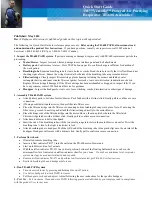
26
CXRC-SVX01J-EN
Field Piping (Air-Cooled Discharge/Liquid
Lines)
1. Ensure all required field installed piping pressure
tests are completed in accordance with national
and/or local codes.
2. Close liquid line angle valve.
3. Connect R-410A refrigerant cylinder to high side
charging port (at Remote Condenser or field
supplied discharge line access port). Add
refrigerant to reach pressure of 12 to 15 psig.
4. Disconnect refrigerant cylinder. Connect dry
nitrogen cylinder to high side charging port and
increase pressure to 150 psig. Do not exceed high
side (discharge) unit nameplate design pressure.
Do not subject low side (suction) components to
high side pressure.
5. Check all piping joints, valves, etc. for leaks.
Recommend using electronic detector capable of
measuring 0.1 oz/year leak rate.
6. If a leak is located, use proper procedures to
remove the refrigerant/nitrogen mixture, break
connections and make repairs. Retest for leaks.
Ensure all service valves are open.
System Repair
1. If system is water cooled with service valves, or air
cooled, high and low side may be tested
independently by closing liquid line angle valve and
water cooled unit discharge line ball valve.
Otherwise leave all valves open and DO NOT
exceed low side design pressure.
2. Connect R-410A refrigerant cylinder to charging
port, add refrigerant to reach pressure of 12 to 15
psig.
3. Disconnect refrigerant cylinder. Connect dry
nitrogen cylinder to high side charging port and
increase pressure to 150 psig. DO NOT exceed unit
nameplate design pressures. If testing complete
system, low side design pressure is maximum.
4. Check piping and/or components as appropriate for
leaks.
5. Recommend using electronic detector capable of
measuring 0.1 oz/year leak rate.
6. If a leak is located, use proper procedures to
remove the refrigerant/nitrogen mixture, break
connections and make repairs. Retest for leaks.
Ensure all service valves are open.
System Evacuation Procedures
1. Each refrigeration circuit must be evacuated before
the unit can be charged and started.
2. Use a rotary type vacuum pump capable of pulling
a vacuum of 100 microns or less.
3. Verify that the unit disconnect switch and the
system control circuit switches are off.
4. Oil in the vacuum pump should be changed each
time the pump is used with high quality vacuum
pump oil. Before using any oil, check the oil
container for discoloration which usually indicates
moisture in the oil and/or water droplets. Moisture
in the oil adds to what must be removed from the
system, increasing pump down time.
5.
When connecting the vacuum pump to a
refrigeration system, it is important to manifold the
vacuum pump to both the high and low side of the
system (liquid line access valve and suction line
access valve). Follow the pump manufacturer’s
directions for the proper methods of using the
vacuum pump.
6. The lines used to connect the pump to the system
should be copper and of the largest diameter that
can practically be used. Using larger line sizes with
minimum flow resistance can significantly reduce
evacuation time.
IIm
mp
po
orrtta
an
ntt:: Rubber or synthetic hoses are not
recommended for system evacuation
because they have moisture absorbing
characteristics which result in excessive
rates of evaporation, causing pressure
rise during the standing vacuum test.
This makes it impossible to determine if
the system has a leak, excessive
residual moisture, or a continual or high
rate of pressure increase due to the
hoses.
7. An electronic micron vacuum gauge should be
installed in the common line ahead of the vacuum
pump shutoff valve, as shown in . Close Valves B
and C, and open Valve A.
8. Start the vacuum pump, after several minutes, the
gauge reading will indicate the maximum vacuum
the pump is capable of pulling. Rotary pumps
should produce vacuums of 100 microns or less.
N
NO
OT
TIIC
CE
E
M
Mo
otto
orr W
Wiin
nd
diin
ng
g D
Da
am
ma
ag
ge
e!!
F
Fa
aiillu
urre
e tto
o ffo
ollllo
ow
w iin
nssttrru
uccttiio
on
nss b
be
ello
ow
w cco
ou
ulld
d rre
essu
ulltt iin
n
cco
om
mp
prre
esssso
orr m
mo
otto
orr w
wiin
nd
diin
ng
g d
da
am
ma
ag
ge
e..
D
Do
o n
no
ott u
usse
e a
a m
me
eg
go
oh
hm
m m
me
ette
err o
orr a
ap
pp
plly
y v
vo
olltta
ag
ge
e
g
grre
ea
atte
err tth
ha
an
n 5
50
0 V
VD
DC
C tto
o a
a cco
om
mp
prre
esssso
orr m
mo
otto
orr
w
wiin
nd
diin
ng
g w
wh
hiille
e iitt iiss u
un
nd
de
err a
a d
de
ee
ep
p v
va
accu
uu
um
m..
9. Open Valves B and C. Evacuate the system to a
pressure of 300 microns or less. As the vacuum is
being pulled on the system, there could be a time
when it would appear that no further vacuum is
being obtained, yet, the pressure is high. It is
recommended that during the evacuation process,
the vacuum be broken to facilitate the evacuation
process.
10. To break the vacuum:







































